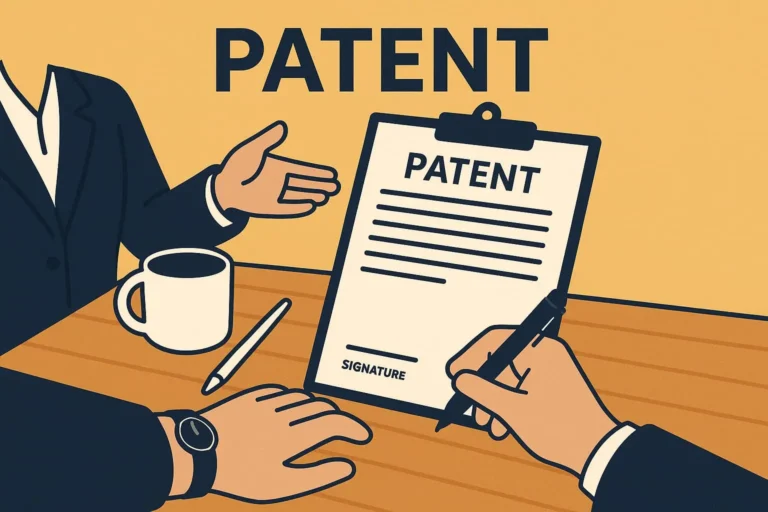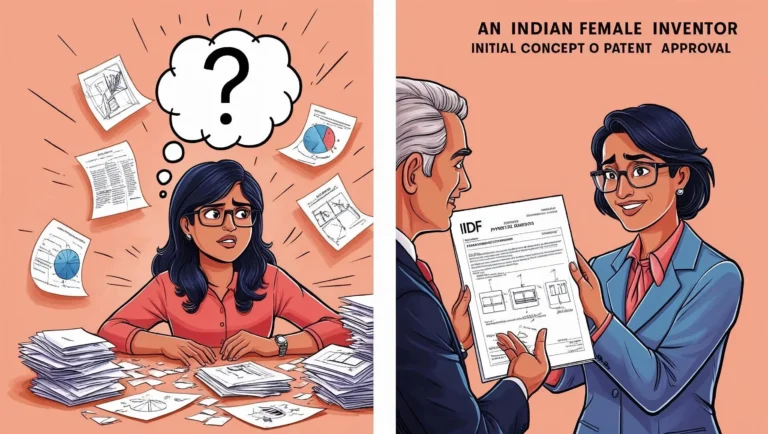The Ultimate Guide: How to Analyze Novelty Search Reports for Patent Success
Table of Contents
- Why Should You Read This Article on Novelty Search Report Analysis from Start to End?
- Understanding Novelty in Patent Law
- What Does “Lack of Novelty” Mean?
- Inventor’s Options When Facing Novelty Issues
- Moving Beyond Novelty: The Inventive Step Criteria
- Demonstrating Inventiveness
- Practical Example: Gas Stove Knob Invention Analysis
- What to Expect from Your Patent Attorney’s Novelty Search Report
- Guidance on Reviewing the Report
- Conclusion
- Related FAQs
Why Should You Read This Article on Novelty Search Report Analysis from Start to End?
After helping hundreds of inventors through my patent consultancy, I’ve observed that while many inventors conduct or commission novelty searches, most struggle to properly interpret the search results. This critical skill gap often leads to misguided decisions—either abandoning truly novel ideas or pursuing patents for inventions that will inevitably face rejection.
This article aims to demystify the process of analyzing a novelty search report, drawing from my years of experience helping inventors navigate this complex terrain. I’ll guide you through understanding the fundamental criteria of novelty and inventive step in simple, straightforward language, show you how to systematically compare your invention against prior art, and provide practical examples of how to make informed decisions based on your findings.
By the end of this article, you’ll be equipped to critically analyze a novelty search report, identify the true patentability potential of your invention, and communicate effectively with patent professionals—ultimately saving valuable time and money in your innovation journey.
Understanding Novelty in Patent Law
In simple terms, novelty means your invention must be new—something that hasn’t been done before anywhere in the world. This seemingly straightforward concept is actually the first major hurdle your invention must clear on the path to patentability.
To explain novelty in everyday language: imagine you’ve built what you believe is the world’s first solar-powered coffee maker. For this invention to have novelty, no one, anywhere in the world, at any time in the past, should have publicly disclosed, used, or patented a solar-powered coffee maker with the same essential features as yours.
The novelty assessment isn’t subjective—it’s binary. Your invention either has novelty or it doesn’t. If even a single document or public disclosure reveals all the essential elements of your invention functioning in the same way, your invention lacks novelty.
This is why understanding how to analyze novelty search reports is crucial. These reports identify potential “prior art”—existing technologies, publications, or products that might destroy the novelty of your invention.
What Does “Lack of Novelty” Mean?
When patent examiners or attorneys say an invention “lacks novelty,” they’re indicating that everything your invention claims to do has already been disclosed in a single piece of prior art. This situation is also called “anticipation”—your invention is anticipated by existing technology.
Prior art encompasses a wide range of materials:
- Granted patents and published patent applications worldwide
- Scientific and technical publications
- Commercial products and their documentation
- Public demonstrations or presentations
- Information published on websites
- Trade journals and catalogs
- Any other public disclosure
For novelty to be destroyed, a single piece of prior art must disclose all the essential elements of your invention. If your invention combines features from multiple sources, it may still have novelty (though it might face challenges with the inventive step requirement, which we’ll discuss later).
Single Prior Art Disclosure: Anticipation
Let’s illustrate how a lack of novelty works with a simple table showing a hypothetical invention and how it might be fully anticipated by a single prior art reference:
Let’s briefly examine the coffee maker with solar panels invention referenced in our example:
A solar-powered coffee maker is an innovative appliance that combines traditional coffee brewing functionality with solar energy technology. The core concept integrates photovoltaic cells (solar panels) directly into the coffee maker’s design, allowing it to operate without conventional electrical power sources. This makes it particularly valuable for camping, outdoor activities, emergency situations, power outages, or off-grid living.
| Essential Features of Your Invention | Disclosure in Prior Art D1 | Novelty Assessment |
|---|---|---|
| A coffee maker with solar panels | A beverage brewing apparatus incorporating photovoltaic cells for power | Disclosed |
| Energy storage battery for nighttime use | Internal battery system stores excess solar energy for operation during insufficient light conditions | Disclosed |
| Automatic brewing timer | Programmable timer module initiates brewing sequence at user-defined times | Disclosed |
| Temperature-maintaining heating element | Secondary heating element maintains optimal beverage temperature after brewing completion | Disclosed |
| Mobile app control capability | Wireless connectivity enabling remote operation through a dedicated mobile application | Disclosed |
In this example, we can see that every essential feature of your invention is thoroughly disclosed in the single prior art document D1. The patent doesn’t just broadly mention similar concepts—it describes the same components, functioning in the same way, to achieve the same results as your invention.
This constitutes a clear case of “anticipation” under patent law. Your invention lacks novelty because every element is already disclosed in this existing patent. The prior art doesn’t need to use the exact same words you use to describe your invention; it only needs to disclose the same technical concepts and functionality.
When faced with this situation, a patent examiner would reject your application citing D1 as anticipatory prior art under the relevant section of patent law (e.g., 35 U.S.C. § 102 in the United States, Section 2(1)(e) in the Indian Patents Act). The rejection would point to specific paragraphs and figures in the document that disclose each element of your claims.
This is why detailed feature-by-feature mapping is crucial when analyzing novelty search reports. By methodically comparing each element of your invention against the prior art, you can determine whether your invention truly offers something new or has been anticipated by existing technology.
Inventor’s Options When Facing Novelty Issues
When your novelty search reveals that your invention lacks novelty, you generally have two main options:
- Modify Your Invention: Carefully analyze what specific features are disclosed in the prior art and consider how you might add new elements or modify existing ones to create something truly novel. The key is to identify gaps or problems in the existing technology that your modified invention can address.
- Abandon the Patent Pursuit: Sometimes, the most economical decision is to accept that your invention has been anticipated and redirect your creative energy toward an innovation. This isn’t a failure—it’s a validation of your market awareness, as you independently conceived something valuable enough that others had already pursued it.
If your invention passes the novelty test, congratulations! But your patent journey has just begun. Next, your invention must face an even more challenging assessment: the inventive step criteria.
Moving Beyond Novelty: The Inventive Step Criteria
While novelty asks, “Is it new?”, the inventive step criterion (also called “non-obviousness” in some countries) asks “Is it sufficiently innovative?” This second requirement demands that your invention wouldn’t be obvious to a person with ordinary skill in your technical field.
In simple terms, even if no single document describes your exact invention (meaning it has novelty), patent offices will still reject your application if they determine that combining existing technologies in the way you have would be obvious to a skilled professional in your field.
The inventive step assessment considers whether a person with ordinary technical knowledge would naturally combine different pieces of prior art to arrive at your invention without requiring any creative leap or solving any technical problem in an unexpected way.
Illustrating Lack of Inventive Step
Here’s a tabulated example showing how an invention might have novelty but lack inventive step:
| Essential Features of Your Invention | Prior Art 1 (D1) | Prior Art (D2) | Inventive Step Assessment |
|---|---|---|---|
| Solar-powered coffee maker | Solar-powered kitchen appliances including toasters and kettles | – | Known technology in related appliances |
| Dual brewing temperatures for different coffee types | – | Coffee maker with selectable brewing temperatures for optimal extraction | Known feature in coffee makers |
| Voice activation capabilities | Voice-controlled kitchen appliance activation system | – | Known technology in kitchen appliances |
| Water filtration system | – | Integrated water filtration system for beverage brewers | Known feature in coffee makers |
| Combination of all features | Not disclosed in a single document | Not disclosed in a single document | Obvious combination of known features with predictable results |
In this scenario, while no single document discloses all features of your invention (meaning it has novelty), the combination is considered obvious because:
- Each element performs its expected function
- The combination yields predictable results
- A skilled person would have clear motivation to combine these known elements
Demonstrating Inventiveness
When facing inventive step challenges, inventors can demonstrate their invention’s patentability by showing:
Technical Advancement
Your invention must solve a technical problem in a non-obvious way. For example, if your solar-powered coffee maker includes a novel energy management system that doubles efficiency compared to simply combining existing solar and coffee technologies, this technical advancement may demonstrate inventiveness.
For instance, if you developed a unique thermal storage system that uses phase-change materials to maintain brewing temperature with 80% less solar panel surface area than would be conventionally required, this represents a technical advancement that wasn’t obvious from merely combining existing technologies.
Economic Significance
Sometimes, inventions that create substantial economic advantages through unexpected technical effects can demonstrate inventiveness. For example:
If your solar coffee maker design reduces manufacturing costs by 60% through an innovative integration method, or if it extends the product lifespan threefold through a novel power regulation system, these economically significant improvements might help establish inventiveness.
A real-world example would be the development of capsule-based coffee systems (like Nespresso). While coffee makers and single-serving packaging both existed separately, the specific implementation created dramatic economic significance through convenience, consistency, and reduced waste, demonstrating inventiveness despite combining known elements.
Practical Example: Gas Stove Knob Invention Analysis
Let’s analyze a hypothetical gas stove knob invention with visual indicators against prior art to illustrate how to assess both novelty and inventive step:
| Features of Gas Knob Invention | Prior Art D1 | Prior Art D2 | Prior Art D3 |
|---|---|---|---|
| Gas stove knob with rotational control | Rotational control knob for gas cooking appliances | Ergonomic rotational knob for stove control | Standard gas stove control knob |
| Sliding indicator that moves based on knob rotation | Not disclosed | Mechanical indicator linked to knob rotation showing position | Not disclosed |
| Window on knob face showing indicator | Not disclosed | Not disclosed | Transparent portion on knob face |
| Color-based visual feedback (red/green) | LED color indicators showing burner status | Not disclosed | Color-coded markings on knob surface |
| Mechanical sliding system requiring no power | Not disclosed | Purely mechanical position indicator | Not disclosed |
Novelty Analysis:
Looking at the table above, we can see that no single prior art document discloses all features of our gas knob invention. Prior Art 1 shows rotational knobs with LED indicators but doesn’t have the sliding mechanical indicator or window. Prior Art 2 has a mechanical indicator but lacks the window and color-based feedback. Prior Art 3 has a transparent portion but doesn’t specifically disclose a sliding indicator or the red/green color scheme.
Therefore, our gas knob invention appears to have novelty since no single prior art document discloses all its essential features.
Inventive Step Analysis:
For inventive step, we need to consider whether combining elements from these prior arts would be obvious to a person skilled in the field of gas stove controls.
One could argue that combining the mechanical indicator from Prior Art 2 with the transparent window concept from Prior Art 3 and the color-coding from Prior Art 1 might be considered an obvious combination.
However, our invention could demonstrate inventiveness if:
- Technical Advancement: The specific implementation of the sliding indicator within the window provides better visibility in low-light kitchen conditions compared to existing solutions, solving a recognized problem in the field.
- Economic Significance: The purely mechanical design eliminates the need for electronics and power sources, reducing manufacturing costs by 75% compared to LED-based indicators while increasing reliability and lifespan.
- Unexpected Effect: Testing shows that users react 40% faster to emergency shutoff needs with our visual system compared to conventional knobs, representing an unexpected safety improvement.
By highlighting these aspects, particularly if they solve long-standing problems in the field, we can build a case for inventive step despite the individual elements existing in separate prior arts.
What to Expect from Your Patent Attorney’s Novelty Search Report
When you commission a novelty search from a patent attorney or agent, you should expect a comprehensive and clear report that helps you make informed decisions. Unfortunately, many inventors receive vague or overly technical reports that don’t provide actionable guidance. Here’s what you should expect and demand from a professional novelty search report:
- Detailed Search Methodology: The report should clearly explain which databases were searched, which keywords and classification codes were used, and what time period was covered.
- Comprehensive Feature Mapping: Each key feature of your invention should be systematically mapped against the most relevant prior art documents, similar to the tables shown above.
- Clear Anticipation Analysis: For novelty assessment, the report should explicitly identify which features are disclosed in which documents, highlighting any single document that might anticipate your entire invention.
- Combination Analysis: For inventive step assessment, the report should analyze which combinations of documents might render your invention obvious, explaining the rationale for why these documents would be combined.
- Unambiguous Conclusion: The report should provide a clear conclusion about the patentability of your invention, avoiding vague language like “may be patentable” without supporting analysis.
- Strategic Recommendations: The report should offer practical next steps based on the findings, such as specific modifications to enhance patentability or areas where your invention shows the strongest novelty and inventiveness.
If your patent attorney delivers a report that simply lists potentially relevant patents without the above elements, request clarification. Ask them to specifically identify which features of your invention are disclosed in which prior art documents, and to provide their reasoning for any inventive step concerns.
Guidance on Reviewing the Report
When reviewing your novelty search report, follow these systematic steps to extract maximum value:
Compare Key Elements of Your Invention: Focus on the key elements or claims of your invention and compare them with those mentioned in the prior art. Note similarities and differences, as these will be crucial in determining the novelty and non-obviousness of your invention.
Evaluate Closely Related Prior Arts: Pay particular attention to prior arts that are closely related to your invention. Analyzing how your invention differs or improves upon these will help in formulating a strong patent application.
Identify Overlaps and Gaps: Look for any overlaps between your invention and prior art. Equally important is to identify gaps where your invention adds something new or solves a problem not addressed previously.
Focus on Problem-Solution: Identify what specific problem your invention solves and how this solution differs from the approaches in the prior art. Often, the inventive step lies not in the components themselves but in recognizing and solving a problem in a non-obvious way.
Look for Combination Threats: Be particularly attentive to prior art documents that, while not individually threatening your novelty, might be logically combined to challenge your inventive step. Understanding these potential combinations helps you prepare counterarguments.
Re-evaluate Your Key Innovation Point: Sometimes after reviewing prior art, you might realize that what you thought was your invention’s key innovation isn’t actually its strongest patentable aspect. Use the search results to refocus your patent strategy on the truly novel and inventive elements.
Conclusion
Analyzing a novelty search report effectively is a crucial skill for inventors seeking patent protection. By understanding the fundamental criteria of novelty and inventive step, and systematically comparing your invention against prior art, you can make informed decisions about whether to proceed with a patent application, modify your invention, or redirect your efforts.
Remember that the novelty search process isn’t just about determining patentability—it’s about gaining valuable insights into your field of innovation, understanding the competitive landscape, and identifying opportunities for meaningful advancement. Even when search results reveal challenges to patentability, they often illuminate paths to improving your invention or developing new innovations that build upon existing technology.
As an inventor, demanding thorough, clear, and actionable novelty search reports from your patent professionals is your right. By knowing what to look for and how to interpret the findings, you become an active participant in your patent strategy rather than a passive recipient of professional opinions.
Finally, keep in mind that analyzing novelty search reports is both an analytical and creative process. While the analysis requires methodical comparison and evaluation, responding to the findings often demands creative problem-solving to enhance patentability while preserving your invention’s core value proposition.
Related FAQs
- How much detail should a professional novelty search report include?
A professional novelty search report should include a clear search methodology, a comprehensive list of relevant prior art, detailed feature-by-feature mapping against your invention, specific citations of where each feature appears in the prior art, an unambiguous conclusion about patentability, and actionable recommendations. The report should be thorough enough that you can make an informed decision about proceeding with your patent application. - Can I challenge a patent examiner’s novelty rejection?
Yes, you can challenge a patent examiner’s novelty rejection through written arguments and/or amendments to your claims. Effective challenges typically involve demonstrating that the cited prior art fails to disclose at least one essential feature of your invention, showing that the examiner misinterpreted either your claims or the prior art, or amending your claims to clearly distinguish your invention from the cited documents. Working with a patent attorney is highly recommended when preparing such responses. - What’s the difference between lack of novelty and lack of inventive step rejections?
A lack of novelty (anticipation) rejection means a single prior art document discloses all essential features of your invention exactly as claimed. A lack of inventive step (obviousness) rejection means that while no single document discloses your entire invention, multiple documents can be logically combined to arrive at your invention in a way that would be obvious to a person skilled in your technical field. Novelty is a binary assessment, while inventive step involves subjective judgment about whether combinations would be obvious. - How do I find the most relevant prior art documents for my invention?
To find the most relevant prior art, use multiple search approaches: keyword searching with various synonyms and technical terms, classification-based searching using patent classification codes (CPC/IPC), citation searching from related patents (both forward and backward citations), and inventor/assignee searching of key companies or individuals in your field. Combine these approaches and review both patent and non-patent literature, including academic papers, product manuals, and industry publications. - What makes a technical feature “essential” when analyzing novelty?
A technical feature is considered “essential” if it appears in the independent claims of your patent application and contributes to solving the technical problem addressed by your invention. Essential features are those that define the core innovation and distinguish it from prior technology. When analyzing novelty, focus on these essential features rather than optional or auxiliary features that might appear only in dependent claims. Identifying essential features requires understanding both the technical and legal aspects of your invention. - How can I strengthen my patent application after a novelty search?
After a novelty search, strengthen your application by highlighting features that differentiate your invention from prior art, focusing claims on unique combinations not found in existing technology, developing robust fallback positions through well-crafted dependent claims, providing detailed examples of technical advantages in your specification, addressing potential obviousness arguments preemptively, and considering divisional or continuation applications for aspects not covered in your main filing. Adjusting your application based on novelty search findings significantly improves your chances of securing meaningful patent protection.





